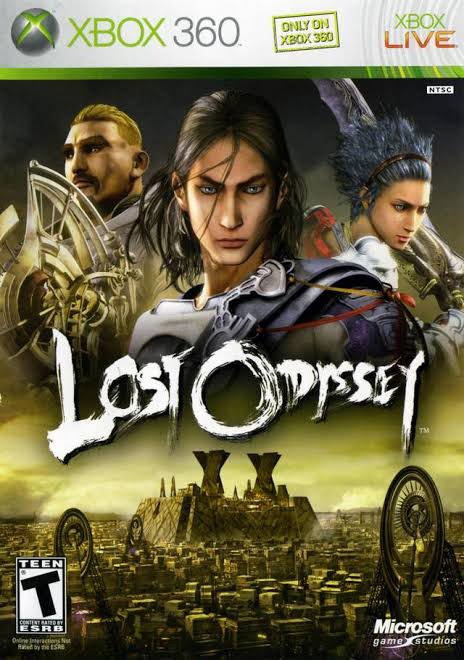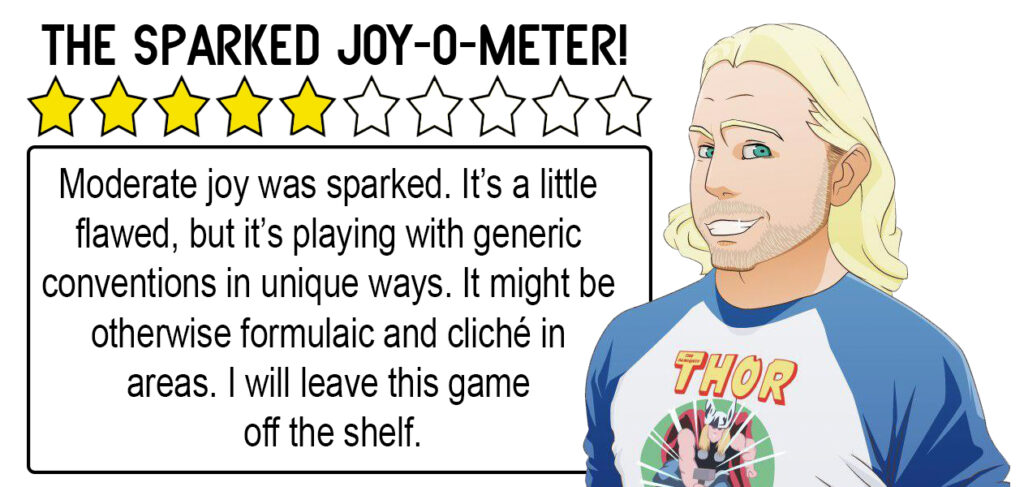Lost Odyssey

Lost Odyssey
It’s been a hot minute since I’ve posted on the blog. I want to write more, but work and research often get in the way. Still, I’ll aim to be a bit more consistent in the coming months. This time around, I took stock of my Xbox 360 JRPGs. During the seventh-generation console war, I pivoted and picked up a 360. It was difficult to find a PS3, and when they were available, they were $600. The Wii was novel, but I wasn’t initially impressed with its game library (I eventually purchased both systems). That left the 360, and I must admit that Christmas was pretty sweet since I immediately acquired five games: Dead or Alive 4, Rainbow Six: Vegas, Gears of War, Dead Rising, and Phantasy Star Universe. I grew up with JRPGs, so you’d think I’d be clamoring to play PSU. Unfortunately, it was a weak game (baller soundtrack, though). The 360 was known for many great games, but JRPGs weren’t typically in the conversation. In fact, most 360 JRPGs were and are garbage. In 2023, I visited a retro game store in Denver and asked for some 360 JRPGs. I picked up five or so at $10 a pop. None of them broke the bank, so I was hoping to find a diamond in the rough. Unfortunately, all of them were “mid” as the kids might say. I’ll do a collective writeup on them all one day, but I can’t imagine any of them will get more than 300 words.
While most 360 JRPGs aren’t anything to write home about, gamers continue to praise one in particular: Mistwalker’s Lost Odyssey. Featuring the creative talents of creators like Hironobu Sakaguchi and Nobuo Uematsu, Lost Odyssey is a love letter to both Final Fantasy and old school, turn-based RPGs. However, it took me years to get into this one. Hell, I knew about the soundtrack roughly a decade before I even bought the game. When I finally started it in 2021 on a whim, I ultimately shelved it until now due to an insane difficulty spike with a worm-like boss in the first disc. Fast forward to 2024, and it was probably time to not just play but ultimately beat what many consider to be the best 360 JRPG. Unfortunately, I came up a bit short. I plowed through the first three discs, but the walkthrough I consulted for the final disc indicated that it was going to be a dungeon romp. I felt I didn’t have the time to keep playing given my current backlog, so I watched a let’s play just for the cutscenes (sorry). Anywho, here are my overall thoughts.
The Gameplay
To be honest, I’m mostly indifferent to Lost Odyssey’s gameplay. It has much in common with several Final Fantasy games, but it’s mostly a traditional turn-based game that doesn’t break much new ground. One interesting note is that the “immortal” characters (more on them later) can equip skill items in which they essentially memorize a skill and plug it into a designated slot. So, for example, if the equipped item promises to protect again paralysis, after a couple of battles, the character can then equip that skill while also equipping a new item to memorize a new skill. The immortal characters can also learn skills through the mortals in a similar manner. While interesting, there are a finite number of skills that an immortal character can equip at a given time. The player can increase this number thanks to an item called a “Slot Seed,” but there are only about 48 of these scattered across the world map. Leveling up in the game also isn’t particularly fun as it’s mostly a grind. However, at the start of the second disc, the game offers a “cheat” of sorts via an enemy called a Silver Kelolon. Like Metal Slimes in Dragon Quest games, the Silver Kelolon is basically indestructible and will immediately flee the battle. However, with a bit of luck, defeating one will immediately raise the characters’ level by one (until about Level 45). Spend an hour or two doing this, and you’ll be at a high enough level to beat the game. While I wasn’t particularly impressed with the gameplay, Lost Odyssey shines in other ways.
The World
Not too many bells and whistles here. It’s a standard fantasy RPG world. As the story begins, an uneasy peace exists between the three nations of Uhra, Numara, and Gohtza. Uhra is sort of a cross between Tatooine and Dalmasca in Final Fantasy XII. Numara is your typical idyllic, artistic country in which the inhabitants are probably smoking a ton of weed. Meanwhile, Gohtza bears a strong resemblance to the Gestahlian Empire in Final Fantasy VI. While the country is considerably less hostile (in fact, Kaim and Sarah are friends with the emperor), the country is filled with Magitek-esque power. There are small towns and locations peppered throughout the world map, but those three nations provide the bulk of it. Eventually, you can traverse the world map thanks to three different ships, although you must hoof most of the map by foot.
The Characters
Character development is where Lost Odyssey begins to separate itself from other JRPGs. The gamer first meets a mercenary named Kaim on the battlefield. A meteor strike wipes out everyone except him, so something is clearly weird about this dude. (He also reminds me Keanu Reeves, so he’s got that going for him.) Well, come to find out, Kaim is immortal. However, he’s an amnesiac immortal, so the poor guy is a husk with zero understanding of the world around him. Occasionally, an interaction or event will trigger a “dream,” during which the text on the screen will describe a previous memory that is vaguely similar to what Kaim just experienced. Spoiler: Most are tragic. Eventually, Kaim discovers that there are four other immortals on the planet: a pirate named Seth, Queen Ming of Numara (who, given that this is an early-00’s JRPG, is scantily clad), a researcher named Sarah, and a politician named Gongora (he is the game’s primary antagonist, so more on him later). In addition to the five immortal characters, there are five mortal characters who are intricately linked to their eternal companions. Jansen (a black mage) accompanies Kaim and Seth on their journey as an unwitting spy for Gongora. He also becomes Ming’s love interest. His personality oscillates between lovable goof and borderline-creepy early-00’s romcom male sidekick. I mean, his courtship with Ming begins because he abducts her. Cooke (a white mage) and Mack (a brawler, I guess) are Kaim’s and Sarah’s grandchildren. While both are capable fighters, get ready to steel yourself for stupid JRPG child antics. In one example, they commandeer a magic train in hopes of seeing their dead mother. In addition to Kaim and Seth, the children also seem to share an auntly relationship with Queen Ming. Sed (your shooter) is an elderly pirate who also happens to be Seth’s son. While entertaining, their relationship is also a little weird given that a 60-year-old man still calls his ageless mother “momma.” Finally, Tolten (a swordsman) is the powerless prince of Uhra. Gongora manipulates him (easily) to usurp the throne. He’s originally so incapable that you just want to say, “Great. This effing trope,” but he gradually comes into his own. So, what, exactly, are these five immortal characters doing on this planet? Read on to find out.
Le Story
Given that this is a Sakaguchi jam, Lost Odyssey’s strongest element is its story. Although the immortal characters have been wiped of their memories, they gradually recover them over the course of four discs. Approximately 1,000 years before the events in the game, a planet in a parallel universe observed that this particular planet was giving off some crazy-ass vibes. The planet inhabited by immortals had no idea what these vibes actually were, so they sent five observers down to see what was going on. Eventually, the observers began to realize that these vibes were human emotions, which they found both intriguing and intoxicating. Fortunately, the game can’t be simplified as “Whoaaa! Love is POWERFUL!” as the message is more, “Life is precious and beautiful because it’s ephemeral.” Anywho, since a millennium is a helluva long time, these immortals began to find themselves living among the humans they were sent to observe. Ming becomes known as the “1,000-Year Queen,” Seth becomes a pirate, and Kaim and Sarah get married. Along the way, Gongora said, “Wait. This kind of sucks. I should, like, be a god on this planet.” You know. A completely original idea. Unfortunately, the other immortals stood in his way. He first took something away from each of them. For example, he abducted Kaim’s and Sarah’s daughter, and Kaim was only able to see her on her deathbed shortly after meeting his grandchildren for the first time. Once the immortals were all, “Hey, Gongora. You suck. Stop sucking,” he was all, “You know what? Lose your memories and get out of my way.” It worked! Eventually, the immortals corner an all-powerful Gongora at the end of the game. While they win the battle, the mortal characters become trapped in a magical barrier, one that slowly kills them. Seth sacrifices herself by pushing Gongora through an interdimensional wormhole that takes both back to their realm, one in which they lose their corporeal forms. Everyone is sad, but they live on with the belief that Seth watches over them. In the epilogue, Ming and Jansen marry, the world is at peace, and both Kaim and Sarah are committed to their duties as grandparents.
While this is a brief summary, and it might seem a little formulaic, it’s a solid story bolstered by character interactions and the world around them. The game also has a ton of built-in lore thanks to each immortal’s memories, although some were a bit long-winded. I also felt that the game was a love letter to Final Fantasy VI as there were too many similarities to ignore. For example, while Gohtza resembles the Gestahlian Empire, Gongora launches a magical barrage on the entire nation so powerful that it freezes over. Essentially, it went from the most powerful empire on the planet to an abandoned Narshe on the World of Ruin map. Additionally, the most powerful characters in the game (the immortals) are sapped of their memories in what might be a nod and a wink to Terra Bradford. Further, Gongora basically becomes Kefka, although one could make the argument that neither are great villains. There are certainly more similarities, but these three jumped out at me as I was playing.
Conclusion
While Lost Odyssey didn’t exactly break any new ground for me, I enjoyed my time with it. I am a little disappointed that I had to resort to a let’s play to finish the story, but I’m glad that I can check it off the list for the time being. The game didn’t veer too far off the typical generic design of a turn-based RPG, nor did it introduce too many minigames that are worth mentioning, but it certainly deserves to be recognized as the best 360 JRPG out there. Unfortunately, if this is the best, that means I must get around to playing the rest of the 360 JRPGs I own. Let me tell you that I’ve started a few of them and, well, I’m not exactly looking forward to that writeup.
